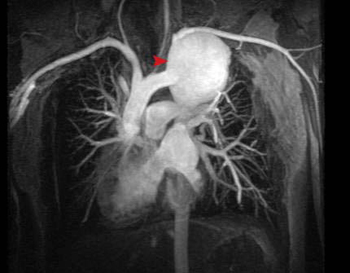Cardiac MRI > Pathology > Disease of the Aorta and Great Vessels > Aortic Aneurysm
Aortic Aneurysm
![]()
Aneurysms can be classified in several different ways. True aneurysms involve all three layers of the wall and are typically due to atherosclerosis, while false aneurysms (pseudoaneurysms) do not involve the complete wall and can be caused by trauma, infection, or as a sequela of dissections or focal ulceration involving the aortic wall.
Aneurysms can also be classified as fusiform (involving the entire circumference of the vessel) or saccular (involving only part of the circumference). Both types are most commonly caused by atherosclerosis, but saccular aneurysms have a higher incidence of being due to infection and trauma. Mycotic (infectious) aneurysms may show perivascular inflammation. Marfan's Disease and syphilis cause aneurysms of the ascending aorta and result in loss of the sinotubular junction (the junction between the coronary sinuses and the tubular portion of the ascending aorta). Thoracic aortic aneurysms usually require surgery when they reach 5.5 cm.

Above is a coronal MRA that shows a large thoracic aortic arch fusiform aneurysm in the vicinity of the subclavian artery. The aneurysm was larger than 5.5 cm, so surgical intervention was necessary.
